Changes in HelpTerrains
Editor Comment
finished
Revision Differences of Revision 21
[TOC] ¶¶
 ¶
Terrains are one of the base graphics in widelands. This page describes how they are implemented and should help with creating new terrains. ¶
In the end you'll find how to get your terrain in the game. ¶
¶
# Properties of the terrain patterns ¶
¶
The patterns for terrains do have some restrictions: ¶
¶
1. the width and height has to be 64 pixel ¶
2. they must be color indexed ¶
3. they couldn't get transparent areas ¶
¶
# Squared patterns as triangles ¶
¶
The surface of the widelands screen consists of a lot of triangles: ¶
¶
 ¶
¶
See [geometry](https://wl.widelands.org/docs/wl/geometry/) for more about this issue. The squared terrain patterns are splitted into triangles to fit the triangles of the surface. This test pattern shows how the splitting is made: ¶
¶
 ¶
¶
The four colors represent the triangles in which the pattern is splitted while rendering. Only one of those triangles are displayed for each triangle: ¶
¶
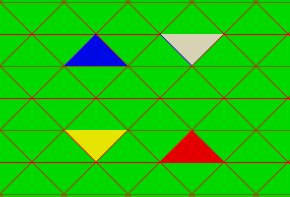 ¶
¶
Note that the red and white triangles of the original pattern are assembled from two patterns to get one big red and one big white triangle. In the above picture the patterns are knowingly spread, to help distuinguish the single patterns. If all patterns are close together, it looks like this: ¶
¶
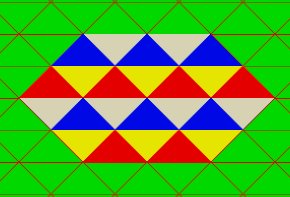 ¶
¶
The patterns do have allways the same area where they adjoin: ¶
¶
Testpattern 2 | Result ¶
---------- | ---------- ¶
 | 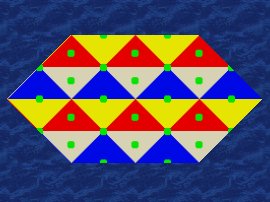 ¶
¶
This is importand to create terrain patterns which do not have visible edges if the patterns of the same type adjoin. ¶
¶
This
¶
Above you have seen, that the resulting triangles will have hard edges. But in game the edges are smooth. This is made with dithering.... ¶
¶
## Dithering ¶
¶
Different types of terrains do not have hard edges if they adjoin. This is made with dithering, a technique which blur the edges from one terrain type to another. Dithering could result in different results: ¶
¶
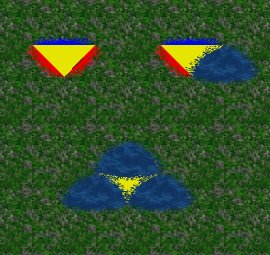 ¶
¶
The above left example shows, that the testpatterns overlaps with the meadow terrain. The right one shows the opposit: The blue terrain overlaps the testpattern. If we use the blue terrain for all edges, the visible area of the testpattern shrinks drastically. ¶
¶
#
¶
¶
Th
¶
**This sett
¶
Each
¶
# How
¶
##
¶
Terrain
-------- | ---------
blue | 240 | This terrain overlaps meadow and the testpattern ¶
¶
## Defining the kind of terrain ¶
¶
There are several possibilities to explain what "kind of" a terrain is. F.e. one could define a terrain as "arable" which means that buildings could be build. This definition is made by the `is` -value in `world/terrains/init.lua` for each terrain. The current implementation allow following values: ¶
¶
Value | Meaning ¶
--------| ------------- ¶
"arable" | Allows building of normal buildings and roads ¶
"mineable" | Allows building of mines and roads ¶
"walkable" | Allows building of roads only ¶
"water" | Nothing can be built here, but ships and aquatic animals can pass ¶
"dead" | Nothing can be built here (not even immovables), and nothing can walk on it ¶
"impassable" | Nothing can be built here, and nothing can walk on it ¶
¶
#### A side note on programming
¶
## Configuration ¶
¶
The configuration of all terrains is done in the file `path/to/gamedata/widelands/world/terrains/init.lua`. The file itself explains the settings at the beginning. You can also refer to the [Online documentation of Terrains](https://wl.widelands.org/documentation/autogen_terrains_lua_world_units_init/) ¶
¶
¶
# A side note on programming ¶
¶
This values defines a description for a terrain, but most of the calculation in widelands do not depend on terrains, they depend on the nodes where the terrains adjoin. Every node has 6 terrains around it. Depending on this terrains the node becomes f.e. walkable, arable or mineable. ¶
¶
## Flags, buildings and immovables ¶
¶
All of the graphical things in widelands is placed not on the terrain itself, they are placed on the edges where the terrains adjoin. Buildings, roads, trees,... animals are walking along the edges: ¶
¶
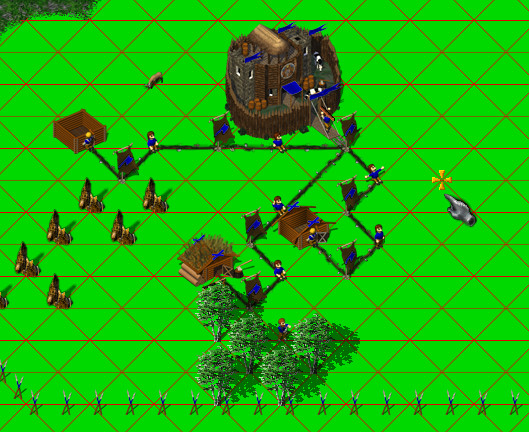
¶
¶
# How to get your terrain into the game ¶
¶





